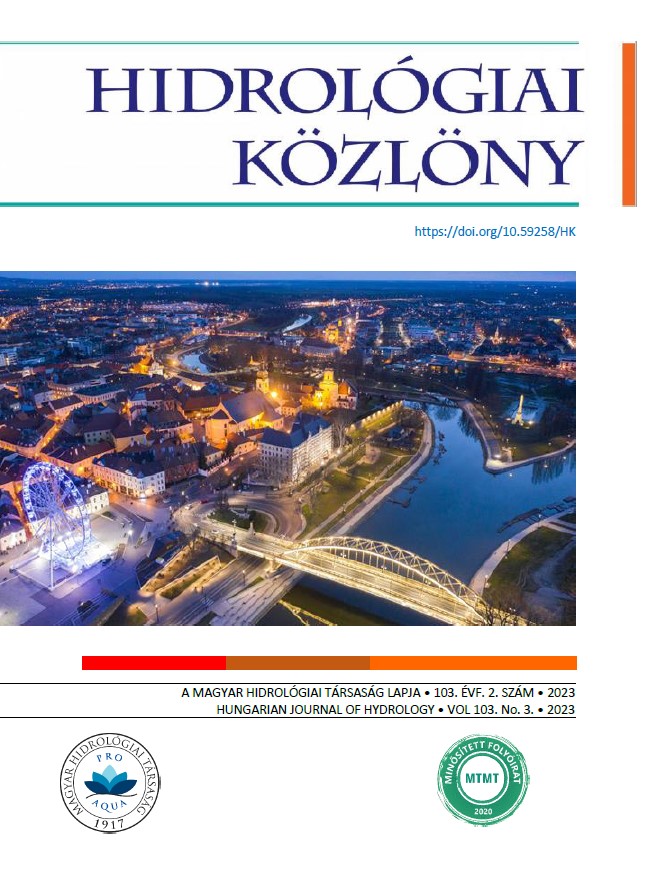A Balaton üledék-víz határfelületén zajló hőcsere jellemzése és hatása
Absztrakt
A tavi ökoszisztémák egyik legfontosabb fizikai paramétere a vízhőmérséklet, ami közvetlen hatással van a biológiai és a kémiai folyamatok dinamikájára. Az olyan sekély tavak esetében, mint például a Balaton, az üledék hőmérséklete szoros kapcsolatban áll a vízhőmérséklettel, ám ennek ellenére a vonatkozó irodalom túlnyomó részében mégis elhanyagolhatónak tekintik a két térrész közti hőcserét. Ez azonban nem minden esetben tehető meg, mivel bizonyos sekély tavak esetében az energiamérleg több, mint 30%-át is kiteheti az üledékkel való hőcsere. Ezért kutatásunkban a Balaton üledék-víz határfelületén zajló hőcserét vizsgáltuk hosszú idejű mérési adatsorokra alapozva. A mérési program során nemcsak a víz- és üledékhőmérsékleteket monitoroztuk nagy időbeli felbontással, hanem hőárammérő-korongok segítségével közvetlenül mértük az üledék felső rétegében a hőáramot. A vizsgálatok során azt kaptuk, hogy a Balaton üledékének hővezetése olyan esetekben, mikor az üledéket nem zavarja meg a vízmozgás, illetve amikor stabil hőmérsékleti-rétegződés jellemzi a határfelületet, jól jellemezhető egy konstans hővezetési együtthatóval, illetve, hogy a felületi hőcsere számottevően kihat az üledék feletti alsó víztér rétegződésére, amelynek jelentős hatása lehet hidrobiológiai folyamatokra, mint például az oldott oxigénszint alakulására az üledék felszínén. Továbbá rámutattunk, hogy a mederhőáram elhanyagolásával a vízhőmérséklet jól modellezhető, azonban hatását a légkör-víz határfelületen zajló hőcserékkel tudjuk kompenzálni. Ezzel elsősorban a szenzibilis, másodsorban pedig a párolgási hőcsere számításánál követünk el kismértékű hibát.
Hivatkozások
Bernhardt, J., Kirillin, G., Hupfer, M. (2014). Periodic convection within littoral lake sediments on the background of seiche-driven oxygen fluctuations. Limnology and Oceanography: Fluids and Environments, 4(1). pp. 17-33. https://doi.org/10.1215/21573689-2683238
Cyr, H. (2012). Temperature variability in shallow littoral sediments of Lake Opeongo (Canada). Freshwater Science, 31(3). pp. 895-907.
Fang, X., Stefan, H. G. (1996). Dynamics of heat exchange between sediment and water. Water Resources Research, 32(6). pp. 1719-1727. https://doi.org/10.1029/96WR00274
Fuente, A. de la. (2014). Heat and dissolved oxygen exchanges between the sediment and water column in a shallow salty lagoon. Journal of Geophysical Research: Biogeosciences, 119(4). pp. 596-613. https://doi.org/10.1002/2013JG002413
Golosov, S., Kirillin, G. (2010). A parameterized model of heat storage by lake sediments. Environmental Modelling & Software, 25(6). pp. 793-801. https://doi.org/10.1016/j.envsoft.2010.01.002
Istvánovics V., Honti M., Torma P., Kousal, J. (2022). Record‐setting algal bloom in polymictic Lake Balaton (Hungary): A synergistic impact of climate change and (mis)management. Freshwater Biology, 67(6). pp. 1091-1106. https://doi.org/10.1111/fwb.13903
Liebethal, C., Foken, T. (2007). Evaluation of six parameterization approaches for the ground heat flux. Theoretical and Applied Climatology, 88(1-2). pp. 43-56. https://doi.org/10.1007/s00704-005-0234-0
Lükő G., Torma P., Weidinger T., Krámer, T. (2022). Air‐Lake Momentum and Heat Exchange in Very Young Waves Using Energy and Water Budget Closure. Journal of Geophysical Research: Atmospheres, 127(12). https://doi.org/10.1029/2021JD036099
Massman, W. J. (1992). Correcting errors associated with soil heat flux measurements and estimating soil thermal properties from soil temperature and heat flux plate data. Agricultural and Forest Meteorology, 59(3-4). pp. 249-266. https://doi.org/10.1016/0168-1923(92)90096-M
Nordbo, A., Launiainen, S., Mammarella, I., Leppäranta, M., Huotari, J., Ojala, A., Vesala, T. (2011). Long-term energy flux measurements and energy balance over a small boreal lake using eddy covariance technique. Journal of Geophysical Research Atmospheres, 116(2). pp 1-17. https://doi.org/10.1029/2010JD014542
Prats, J., Ramos, A., Armengol, J., Dolz, J. (2011). Comparison of Models for Calculation of Diel Sediment-Water Heat Flux from Water Temperatures. Journal of Hydraulic Engineering, 137(10). pp. 1135-1147. https://doi.org/10.1061/(ASCE)HY.1943-7900.0000434
Smith, N. P. (2002). Observations and simulations of water-sediment heat exchange in a shallow coastal lagoon. Estuaries, 25(3). pp. 483-487. https://doi.org/10.1007/BF02695989
Tasnim, B., Jamily, J. A., Fang, X., Zhou, Y., Hayworth, J. S. (2021). Simulating Diurnal Variations of Water Temperature and Dissolved Oxygen in Shallow Minnesota Lakes. Water, 13(14). 1980. https://doi.org/10.3390/w13141980
Torma P., Krámer T. (2017). Modeling the Effect of Waves on the Diurnal Temperature Stratification of a Shallow Lake. Periodica Polytechnica Civil Engineering, 61(2). pp. 165-175. https://doi.org/10.3311/PPci.8883
Torma P., Wu, C. (2019). Temperature and Circulation Dynamics in a Small and Shallow Lake: Effects of Weak Stratification and Littoral Submerged Macrophytes. Water, 11(1), 128. https://doi.org/10.3390/w11010128
Tsay, T., Ruggaber, G. J., Effler, S. W., Driscoll, C. T. (1992). Thermal Stratification Modeling of Lakes with Sediment Heat Flux. Journal of Hydraulic Engineering, 118(3). pp. 407-419. https://doi.org/10.1061/(ASCE)0733-9429(1992)118:3(407)
Wetzel, R. G. (2001). Limnology, Lake and River Ecosystems (Third). London: Elsevier Academic Press.
Zdorovennova, G., Terzhevik, A., Palshin, N., Efremova, T., Bogdanov, S., Zdorovennov, R. (2021). Seasonal change in heat flux at the water-bottom sediment boundary in a small lake. Journal of Physics: Conference Series, 2131(3), 032080. https://doi.org/10.1088/1742-6596/2131/3/032080
Copyright (c) 2023 Sebestyén Dániel Török, Péter Torma, Tamás Weidinge

This work is licensed under a Creative Commons Attribution-NonCommercial-ShareAlike 4.0 International License.




